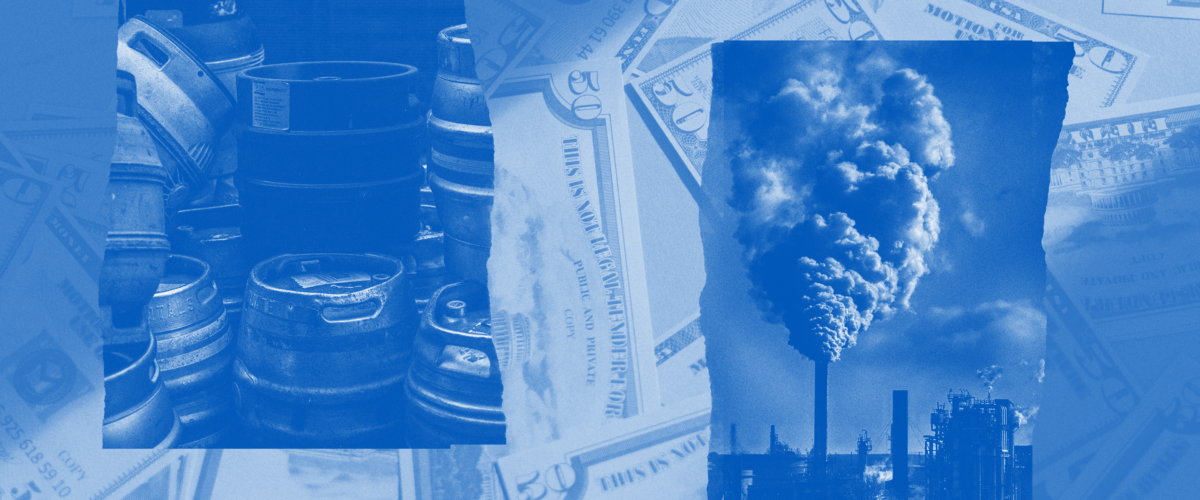Cashing In On Carbon Capture: How Big Oil Will Spend Our Money
Published Oct 17, 2022

Big Oil stands to pocket billions in taxpayer dollars by way of carbon capture, their latest climate scam. Here’s how they’ll do it.
The crises of the past few years have done a number on our economy. From rising rent, to climbing grocery bills; from a deadly pandemic to climate-fueled natural disasters.
Recently, our elected officials have passed two major legislation packages that aim to bring relief to workers and families. These packages have also been touted as environmental wins that will help us fight and adapt to climate change. But they also came with major gifts to Big Oil.
These gifts are endangering our chances for a livable future. And while everyday people struggle to pay their bills, our taxpayer money is headed for Big Oil’s already overflowing pockets.
In one of the greatest heists of our climate crisis, the companies responsible for the crisis are raking in billions of our taxpayer dollars. And much of that money is being poached through the industry’s latest scam — carbon capture and storage.
Carbon Capture Flushes Our Money Down An Oil Well
Carbon capture refers to pie-in-the-sky greenwashing technologies meant to remove carbon pollution from smokestacks or the atmosphere. And Big Oil is all for it, because it means they can go about business as usual — polluting and plundering, just with a shiny new toy attached.
In fact, the corporations responsible for the climate crisis stand to profit from many of the carbon capture projects planned. Thanks to all the recent hype, ExxonMobil announced it expects the carbon capture market to grow $2 trillion through 2040. It’s now positioning itself as a major player in that field, despite their disinterest in clean energy so far.
That’s because rather than combatting climate change, carbon capture will only prolong the fossil fuel industry.
This technology is incredibly energy-intensive. Food & Water Watch found that if every power plant in the U.S. were retrofitted with it, we would use more natural gas and coal than we already do (39 and 43% more, respectively).
Moreover, while proponents claim all the carbon will be stored safely underground, that hasn’t played out so far. At least 95% of CO2 currently captured is used to push more fossil fuels out of the ground via enhanced oil recovery.
Our government has already invested billions of our dollars in carbon capture scams. And that money has only produced more climate pollution and more profits for Big Oil.
The U.S. Has Already Spent Billions On Failed Carbon Capture Projects
The U.S. has piloted carbon capture projects for over a decade now, with little to show for it.
It began with the failure of the 1980s “clean coal” scam, which industry claimed would remove carbon pollution from the coal equation. Then, in 2009, Congress invested $3.4 billion in carbon capture. That money funded nine huge projects, of which only two remain operational. None of the carbon capture power plant projects are still running.
These pilots have failed for a number of reasons, like construction complications and lack of economic viability, even with government subsidies. Moreover, all carbon capture projects have failed to capture the amount of carbon they promised. Many captured less than half. In fact, the use of carbon capture in this country has led to a net increase in emissions, thanks to all the energy it requires.
Despite the failures, faith (and funds) in carbon capture remain alive and well. That’s because some politicians are willing to do the bidding of energy corporation executives who see the climate crisis as yet another money-making opportunity.
If Big Oil Has Its Way, We’ll Keep Spending On Carbon Capture
In recent years, our government has ramped up investments in the carbon capture boondoggle. In 2021, the Bipartisan Infrastructure Law designated more than $7 billion in taxpayer money to carbon capture projects. That’s in addition to the $2.7 billion in regular appropriations from the Department of Energy from 2009 to 2021.
Moreover, in 2008, Congress established 45Q, a tax credit to companies using carbon capture technology. Funded with taxpayer money, companies could “earn” credit with every ton of CO2 they claimed they could capture. By 2020, companies claimed almost all of the available credit (estimated at $886 million) — even though most carbon capture projects failed to work at the scale promised, or at all.
Now, this year’s Inflation Reduction Act will grow the 45Q program, allowing companies to “earn” even more money per ton of captured CO2 claimed. The IRA also lowered the amount of carbon a facility can claim to sequester to qualify for the tax credit. As a result, a congressional research agency estimates that 45Q alone will cost taxpayers $3.2 billion over the next 10 years.
We Can — And Must — Stop Carbon Capture In Its Tracks
Economic and climate anxieties have pushed public opinion ever more in favor of getting our emissions in check. Oil and gas executives have happily hopped on the bandwagon — while getting away with polluting even more and even longer. While corporations tout new climate and “net-zero” goals, they siphon billions of our taxpayer dollars for failing schemes and lip service.
Because they know the truth as much as we do — carbon capture is an unproven, unrealistic racket that distracts from real climate action.
There are plenty of important investments our tax dollars could fund. From renewable energy deployment and climate resilience, to infrastructure improvements and programs supporting working families. But right now, Big Oil is sweet-talking Congress into funneling our money toward their carbon capture scam.
We can’t let them get away with it any longer.
Tell Congress to stop promoting carbon capture and to double down on investments in renewable wind and solar!
Enjoyed this article?
Sign up for updates.
TO TOP


